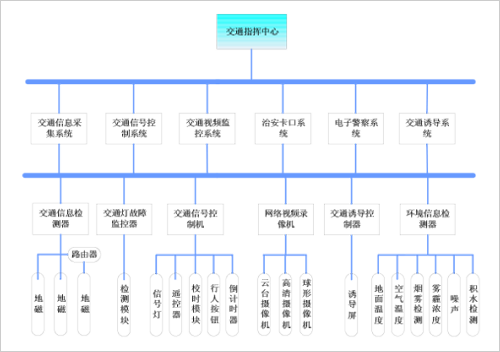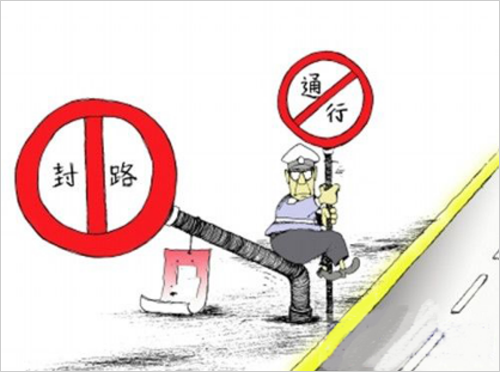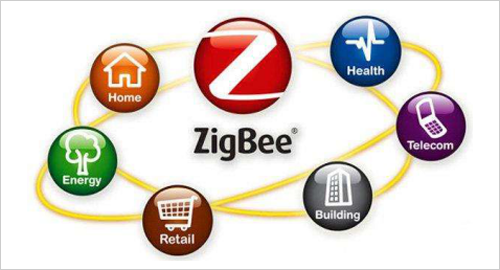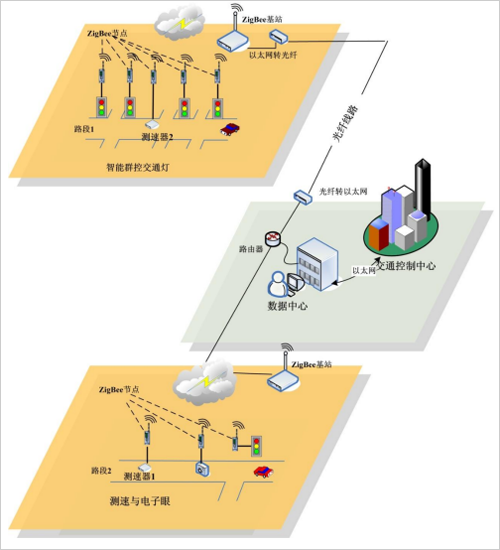Faced with the crossroads of urban congestion, in the face of a fleeting fleet of cars, do you miss the path of your “permission to go†in your hometown? Have you ever watched the green light turn red at the crossroads, but you can only wait in line, but on the way to work, you can only go on a turtle speed course because of congestion and lose driving passion?
In fact, our country has always been committed to promoting the development of intelligent transportation, vigorously rectifying the order of road traffic, and advancing the construction of road safety facilities. What about specific intelligence?
The brain of a smart traffic management system is a traffic command center, and the command center manages multiple subsystems. Each subsystem has its own independent functions and cooperates with each other. These subsystems are built on the underlying hardware devices. The hardware devices are mainly composed of controllers and some detection devices.
Figure 1 Overall scheme of intelligent traffic system
The entire intelligent transportation system is more complicated and complicated. Let's talk about the most common traffic lights today. The main function of the traffic signal control system is to control the red, yellow, green and pedestrian red and green lights of the motor vehicles, and to automatically execute control settings.
The intelligent signal light control system can automatically adjust the corresponding time of passing and forbidden according to the traffic volume of different intersections or the same intersection at different time periods. It plays a decisive role in maintaining the traffic order, improving the intersection traffic rate and avoiding road junction traffic accidents.
With the rapid development of wireless technology, the era of IoE is approaching. Many domestic companies have already launched smart traffic control system solutions based on wireless technology, and have achieved a good social response.
The advantages of adopting wireless communication over traditional wired methods are prominent:
1. Cost of consumables: Traditional cable systems for traffic signals and other control systems need to bury underground power pipes and lay multiple signal lines. The wireless transmission method only needs to connect and take power with the original power system, the signal line does not need to be laid separately, and saves a lot of manpower and mechanical use costs;
2. Construction loss: Traditional wired traffic lights are mostly found in newly built roads. For roads that have already been used, additional traffic lights or post-retrofit projects are in progress, causing significant damage to the roads and making construction difficult. Wireless has more obvious advantages for such projects. It is simple and convenient to add or renovate projects.
3. Troubleshooting and maintenance: For the maintenance or repair of future projects, wireless overhaul is convenient, the replacement of equipment is easy, and the relevance of the wired connection is large;
4. Construction impact: The short-term construction period for wireless reconstruction or repair has little impact on the road. Compared with the long-term road closures necessary for wired construction, the impact on the public is small and the safety is high.
At present, the wireless transmission solutions used in the intelligent transportation industry are more mature than zigbee and LoRa. Here, the zigbee communication solution is mainly introduced.
Zigbee technology is a close-range, low complexity, low power, low data rate, low-cost two-way wireless communication technology or wireless network technology. It is mainly suitable for carrying data traffic with a small amount of traffic and can be embedded in various devices. It also supports geolocation.
Figure 2 zigbee wireless widely used
Compared with the existing various wireless communication technologies, zigbee technology is a technology with low power consumption and high cost performance, and is also a hot spot for embedded applications. Zigbee technology has the following features:
Low power consumption: Due to the low transmission rate of zigbee, the maximum transmit current is only 148mA, and the sleep mode is adopted, and the power consumption is low, so the zigbee device is very power-efficient. It is estimated that the zigbee device can maintain the usage time of up to 6 months to 2 years only by using two AA batteries, and its power consumption is far less than other wireless devices.
Low cost: The initial cost of the zigbee module is around $3, and the zigbee protocol is royalty-free. Low cost is also a key factor for zigbee;
Short delay: The latency of communication delay and activation from sleep is very short. The typical delay of the search device is 30ms, the delay of sleep activation is 15ms, and the delay of active device channel access is 15ms. Therefore zigbee technology is suitable for timekeeping
Demand harsh wireless control (such as industrial control applications) applications;
Large network capacity: A zigbee network with a star structure can accommodate up to 254 slave devices and one master device, and the network composition is flexible. For example, Zhiyuan Electronic Fastzigbee protocol supports the ad hoc network function;
Reliable: A collision avoidance strategy is adopted, and a dedicated time slot is reserved for communication services that require a fixed bandwidth, avoiding competition and conflict in sending data. The MAC layer adopts a fully-confirmed data transmission mode, and each transmitted data packet must wait for the recipient's confirmation message. If there is a problem during the transmission, retransmission can be performed;
Security: ZigBee provides packet integrity checking based on Cyclic Redundancy Check (CRC). It supports authentication and authentication and uses encryption algorithms. Each application can flexibly determine its security attributes.
Figure 3 Wireless signal of intelligent traffic signal
Zhiyuan Electronics has developed a series of low-power, high-performance zigbee modules based on the NXP JN5168 wireless microcontroller, providing a complete application integration solution based on the IEEE 802.15.4 standard ISM band.
The products have been tested and certified by a series of authoritative RF instruments, combined with years of market experience and the actual needs of users in the industry, integrating wireless communication products with extremely complex communication protocols into built-in MCUs, streamlining and simplifying wireless products The development process will enable your products to quickly enter the market at a lower cost, increase competitiveness, and better grasp the opportunities.
Krah Pipe
Krah Pipe
The performance characteristics of the HDPE winding structure wall tube are as follows:
1. The hot state of winding forming welding joint quality is high.
The flat material belt and U-shaped material belt extruded from the mouth die of the extruder in the melting state are evenly wound on the heated roller die according to the predetermined position, which ensures the quality of the fusion joint of the structure wall tube. In particular, in the structural design, the melt joint of the flat material belt is covered by a polyethylene-coated supporting tube, which improves the overall resistance to the external pressure of the product.
2. Good connection quality.
The pipe connection with excellent installation performance adopts the
embedded electric fuse in the socket with the same material socket welding
connection technology. It can achieve zero leakage, ensuring the same life span of the pipeline system and the safety of operation. At the same time, because the product under the condition of the same application as other tubes light weight, and is easy to transport, construction is convenient and quick, and can reduce the construction cost, in the range of applications, without a concrete cushion layer and concrete jaasiel groove can directly apply the tube after qualified, basically, stay do under excavation, side tube, while backfilling, simplifies the construction procedures, shortening the time limit for a project. During the project acceptance, the closed-air test is used instead of the closed-water test, which not only speeds up the acceptance but also saves the complicated work and a lot of test costs in the closed-water test
3. Good flexibility
High-density polyethylene winding structural wall pipe has macro flexibility, and the micro pipe section has strong rigidity and overall resistance to external pressure.
when used under heavy load road surfaces, it can ensure the safety of traffic. Due tothe flexibility of the pipe, it can also reduce the damage loss of the pipe to the minimum in the event of an earthquake, uneven surface settlement, and other geological activities. These characteristics improve the seismic mitigation ability of public facilities.
4. HDPE can be recycled, The main raw material of winding structure wall pipe
is green environmental protection products, such as high-density polypropylene, which doesn`t have any toxicity. There is no dye in the production process. The used pipeline can be 100% recycled. It is a green product of environmental protection.
5. Corrosion resistance, aging resistance, and service life span can be up to 50
years.
High-density polyethylene has the ability to resist chemical corrosion and
erosion. Therefore, when the winding structure wall pipe is conveying corrosive fluid or laying in corrosive soil, it does not need anti-corrosion treatment, and its performance is much better than other pipes. The product in the design process, chooses a reasonable product structure form, to ensure the service life span of the plastic pipe is more than 50 years, and no maintenance is needed in the life span.
6. Tube inner wall roughness, large water transfer around the structure of the
wall tube. Product inner wall roughness N is about 0.010, so the transmission of fluid has lower friction, compared to other products such as cement pipe with a similar diameter the water transfer is greatly improved. Therefore, the smaller HDPE tube can replace the larger cement pipes. In application, under the same conditions, using a wall pipe winding structure can have better reliability compared to the traditional pipe material. The comprehensive benefit is obvious, especially in the narrow construction site, high building density, underground pipeline, complicated traffic busy roads, and acid soil.





